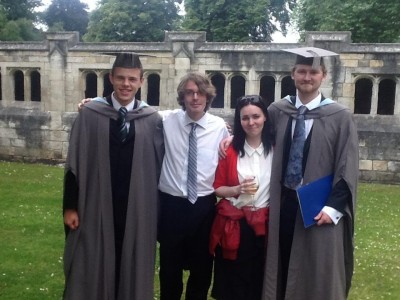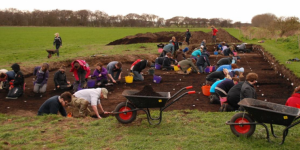I do not exaggerate when I say that I have been dreading this moment for the last 15 months! If you follow our Facebook or Twitter pages for the latest news from The Post Hole team, you will already be aware that with the release of this issue I will be stepping down as Editor-in-Chief and handing over the reins to a new student, just as my four predecessors have done before me.
Few other journals enjoy the same rapidity of change in staff as The Post Hole does. It has been an honour for me to lead the fifth brilliant group of students who have innovatively brought engaging debate and fascinating perspectives on the past to thousands of students, academics and other people interested in the past. Being Editor-in-Chief of The Post Hole has been a very developmental experience for me as I have met hundreds of inspirational people from across the world, learnt first-hand about the amazing array of research different people carry out, and the ways they use their work to assist communities in connecting with their heritage and feeling of identity.
The past matters to us all. An early indication of that to me was discovering the extent people spread awareness of The Post Hole to others and the ever-growing number of submissions we have received from a truly diverse range of people. In the last six months The Post Hole has gained 10,000 brand-new readers via its website, and as each month has passed, the task of selecting five articles to feature in the next issue has got more and more difficult. The Post Hole is successfully breaking down barriers in the dissemination of research and views on the past, not just for under-represented groups like students and non-academic specialists, but now also for people from across borders over the world. In this month alone, The Post Hole has received submissions from Argentina, Australia, Ireland, the Netherlands and the U.S., as well as from closer to home in the UK.
The Post Hole also has its own unique set of challenges. Most significantly, it is run by undergraduate students who have to simultaneously balance their studies, and in some cases also their jobs and families. I still think it remarkable that a group of only five or six people can do all that and still release a new edition of a journal almost every month! Each issue involves three editors to review and proof-read submissions, as well as format and upload content onto the website, someone to design our fantastic covers, and at least one person juggling a Facebook page, Twitter page, and plenty of other advertising opportunities.
Having revealed to you for the first time just how chaotic running this journal can sometimes feel behind our (hopefully!) calm and confident facade, I hope you will share my huge appreciation of the people I have been fortunate to work alongside during the last 15 months.
There are two additional people I wish to credit for the remarkable success of The Post Hole this year. The secret behind much of the journal’s growth this year has been its website, masterfully (and patiently!) redeveloped by Pat Gibbs of Heritage Technology, based at the University of York. The financial support from our Department towards the major redevelopment of our website, and even more importantly, the moral support from its staff, especially the Head of Department, Dr John Schofield, for everything we have done has made our ambitious plans for the year all the more achievable and enjoyable.
Emily Taylor, who is commencing the third and final year of her BA in Archaeology at York, aims to build on the now-proven capacity for The Post Hole to expand the limits of the discipline and increase discourse throughout all levels of archaeology. Emily has served as PR Officer during the last year and I have every confidence that she will help The Post Hole go even further over the year ahead. The contributions from our PR Coordinators at other universities should not be overlooked. I would urge them, and also everyone who enjoys reading The Post Hole, to continue supporting the aims of this voluntarily-run not-for-profit journal by sharing awareness of it with those like you who value and take an interest in the past, whoever and wherever they are.
So here are the final five offerings from the retiring 2012-13 editorial team...
Marco Barrettara introduces us to the startling volume of new 3D visualisation technologies and their archaeological applications that have come about since Anthony Masinton’s guide only four years ago (Issue 6). Barrettara rightly argues that all archaeologists should always keep a close eye on new developments in other fields of research and technology. The diversity of questions archaeology can address require equally eclectic poaching from other fields, otherwise it will become far more limited in its scope than it is at current.
Alistair Galt, now starting a Masters degree at the University of Southampton, explains the creativity and resourcefulness of undergraduate students of different disciplines at the Universities of Durham, Newcastle and Northumbria. I know first-hand the tremendous potential undergraduate students can achieve if they are trusted with a challenging yet rewarding project, and Galt and his fellow students were given just that by the North of England Civic Trust when they evaluated the condition of historic buildings in and around Durham.
The advantages of cross-disciplinary collaboration, both for the outcome of a project and the intellectual development of its participants, are very apparent from Galt’s article, however, James Preece, suggests in his thoroughly interesting response to Paul Joseph de Mola’s critique of narrative in archaeological theory and interpretation (Issue 30) that pluralism has its limitations for the discipline. Whilst I would agree that it does in contexts similar to the examples Preece provides, I would assert that there are many instances where a pluralistic approach to the past is extremely beneficial for ensuring comprehensive and diverse narratives are included in understanding and interaction with the past, both for archaeologists and the public.
It is clear from what I’ve written above that this view of mine is shaped from my experiences with running The Post Hole which aims to widen a discipline that can never be taken for granted as being sufficiently open. However, I fundamentally agree with Preece’s conclusion that archaeology should be framed as a holistic and accurate discipline, as that overlaps with my favoured side of pluralism.
I think when I co-organised the 1st Annual Student Archaeology Conference at the University of York in June, a few of the attendees may have confused its theme of ‘Integrated Archaeology’ as being explicitly associated with community archaeology. To me, an integrated archaeology incorporates the skills and views of a diverse range of people in order to build a more extensive and robust impression of the past.
This may include the involvement of any kind of person. Phoebe Haigh and Sophie Austin, undergraduate students at the University of York, reveal some of the things they found during their excavation field school at the famous Mesolithic site of Star Carr in North Yorkshire. Their work highlights how the active inclusion of students in the learning and feedback processes of the excavation can make it an even more worthwhile endeavour for all involved.
Finally, Nikolah Gilligan, an independent researcher from near Cork, Ireland, introduces us to the methodologies, theory and applications of archaeobotany in archaeological research. This article by Gilligan is the first of two parts and I look forward to finding out more about her field of research in a future edition of The Post Hole by the next editorial team.
All that is left for me to say is thank you for your support and keep reading and writing!









